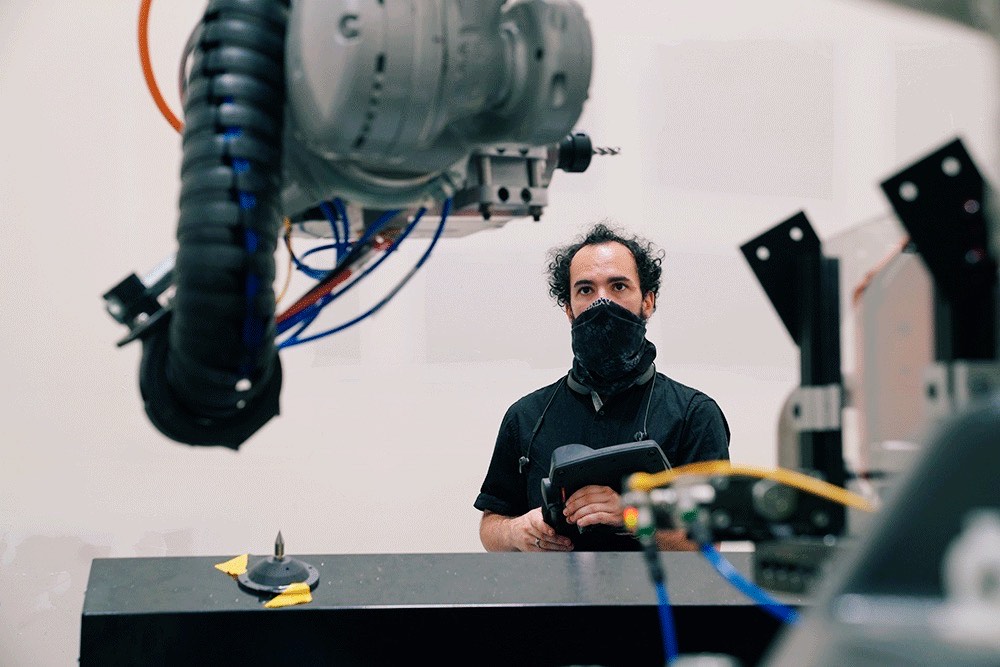Launch vehicles, spacecraft, and in-space services provider Firefly Aerospace has announced it will transition its manufacturing of large parts to an Automated Fiber Placement (AFP) system from Ingersoll Machine Tools, from the start of next year.
Once operational, Ingersoll’s AFP Mongoose Hybrid systems will allow Firefly to produce its all-composite Alpha rocket airframe in just two weeks.
“From the outset Firefly chose to utilize 21st century materials and manufacturing processes in our spacecraft and rocket designs,” said Dr. Tom Markusic, Firefly CEO. “Metallics were the most prevalent aerospace material of the last century; composites, which are stronger and lighter than metallics, are the choice for modern aircraft.
“Firefly’s Alpha is the world’s largest all-carbon-fiber liquid fueled rocket.”

Utilizing AFP for composite structures
While it’s not strictly a 3D printing technology, the use of AFP within the aerospace sector is significant, as is the involvement of Ingersoll. The company developed its Wide and High Additive Manufacturing (WHAM) additive manufacturing system several years ago in partnership with Oak Ridge National Laboratory (ORNL), initially targeting the aerospace, wind energy, automotive, and defense sectors.
Now, Firefly is looking to utilize Ingersoll’s high-speed, large-scale robotic AFP systems to essentially 3D print composite structures with large dimensions, a task which poses limitations when using metal 3D printing.
“Given that we can simply purchase machines which have been developed and proven by the aircraft industry and immediately achieve major cost, weight, and production time savings, it’s obvious to us that AFP is the most efficient and cost-effective approach to future rocket production,” continued Markusic.
Firefly will install its first AFP system at its manufacturing and test facility in Texas in May 2021, after which the Alpha rocket airframe will be requalified using AFP manufacturing processes. The second AFP system and automated assembly line is destined for Firefly’s new Florida Space Coast factory and launch site at Cape Canaveral, set to be installed by the beginning of 2022.
Firefly estimates the facility will be capable of producing 24 Alpha rockets per year, fabricated from all carbon-fiber structures including barrels, fairings, domes, and payload components, using AFP. Meanwhile, the Texas plant will transition to automated developmental builds of Firefly’s larger Beta launch vehicle. It’s estimated that the firm’s new automated rocket factories will deliver a 30-50% reduction in composite materials waste, while reducing hands-on labor, build times, and overall costs.
According to Markusic, integrating Ingersoll’s AFP technology into its production lines represents not only Firefly’s investment in its own future as a company but also in the future of the “cis-lunar space economy”, which refers to the economic activities taking place in space, either on the Moon or in orbit around the Earth.
“As Firefly approaches our first Alpha launch, our focus is transitioning to scaling our operational capabilities to meet the fast-growing commercial, government, and scientific mission demand for space access with the lightest, strongest, fastest built precision-made rocket in the industry,” he added.

The AFP Mongoose Hybrid
Firefly’s Mongoose Hybrid will be the first AFP system equipped with Ingersoll’s new Hawk fiber delivery module, which has been designed and tested with the layup of mild curvature surfaces in mind. The system will also feature Ingersoll’s automatic exchange of multiple composite manufacturing modules that perform in adjacent work areas, enabling the automation of multiple tools and lessening human intervention in the production process.
“Ingersoll has played an important role in enabling breakthrough airframe production for major aircraft designs around the world, including the 787 and A350, and we look forward to supporting Firefly and its innovative approach to the efficient and cost-effective production and further development of its Alpha, Beta, and future spacecraft,” said Chip Storie, CEO of Ingersoll Machine Tools.
“Ingersoll is thrilled to bring our vast experience in automated composite manufacturing and robotics across the aerospace industry into the world of space rocketry and exploration with Firefly.”
3D printing rockets
Additive manufacturing technologies have been used in the development and production of aerospace rockets for some time. One company which has been at the forefront of these developments is rocket-building firm Relativity Space, which after its founding in 2015 grew rapidly to raise $45.1 million in three years.
In 2017, the firm announced it was working on a new Stargate 3D printer which would allow it to go, “from raw material to flight in less than 60 days”, and in the long-term 3D print the first rocket on Mars. A year later, the company signed a contract with the U.S. Air Force to operate its own launch facility on one of their sites and test its 3D printed rockets at Cape Canaveral. Most recently, Relativity Space was called upon by aerospace and defense contractor Lockheed Martin to 3D print projectiles for an upcoming experimental NASA mission.
Other companies operating in this space include Spanish aerospace firm Zero 2 Infinity which is using 3D printing as part of its Blooster balloon-assisted rocket, and British aerospace company Orbex, which announced that its 3D printed rockets will be the first to launch from the UK’s new spaceport in early 2022. Elsewhere, Rocket Lab’s 3D printed Electron Rocket has been raised on its launchpad ahead of the firm’s upcoming mission with the U.S. Space Force, while U.S. start-up Rocket Crafters has concluded testing of its Comet Series hybrid 3D printed rocket engine.

Subscribe to the 3D Printing Industry newsletter for the latest news in additive manufacturing. You can also stay connected by following us on Twitter and liking us on Facebook.
Be sure to subscribe to the Another Dimension podcast on your chosen podcast player to make sure you never miss an episode.
Looking for a career in additive manufacturing? Visit 3D Printing Jobs for a selection of roles in the industry.
Featured image shows a Firefly engine test. Image via Firefly Aerospace.


